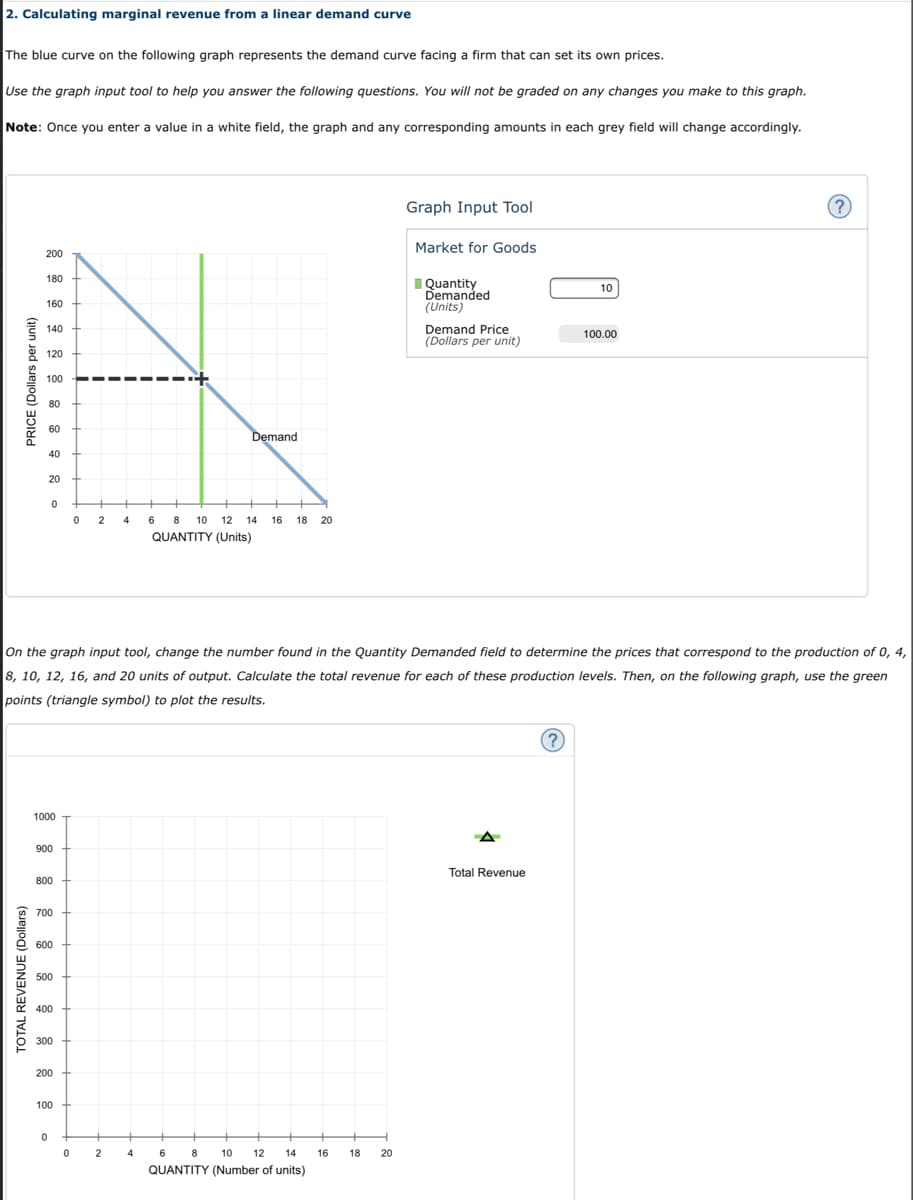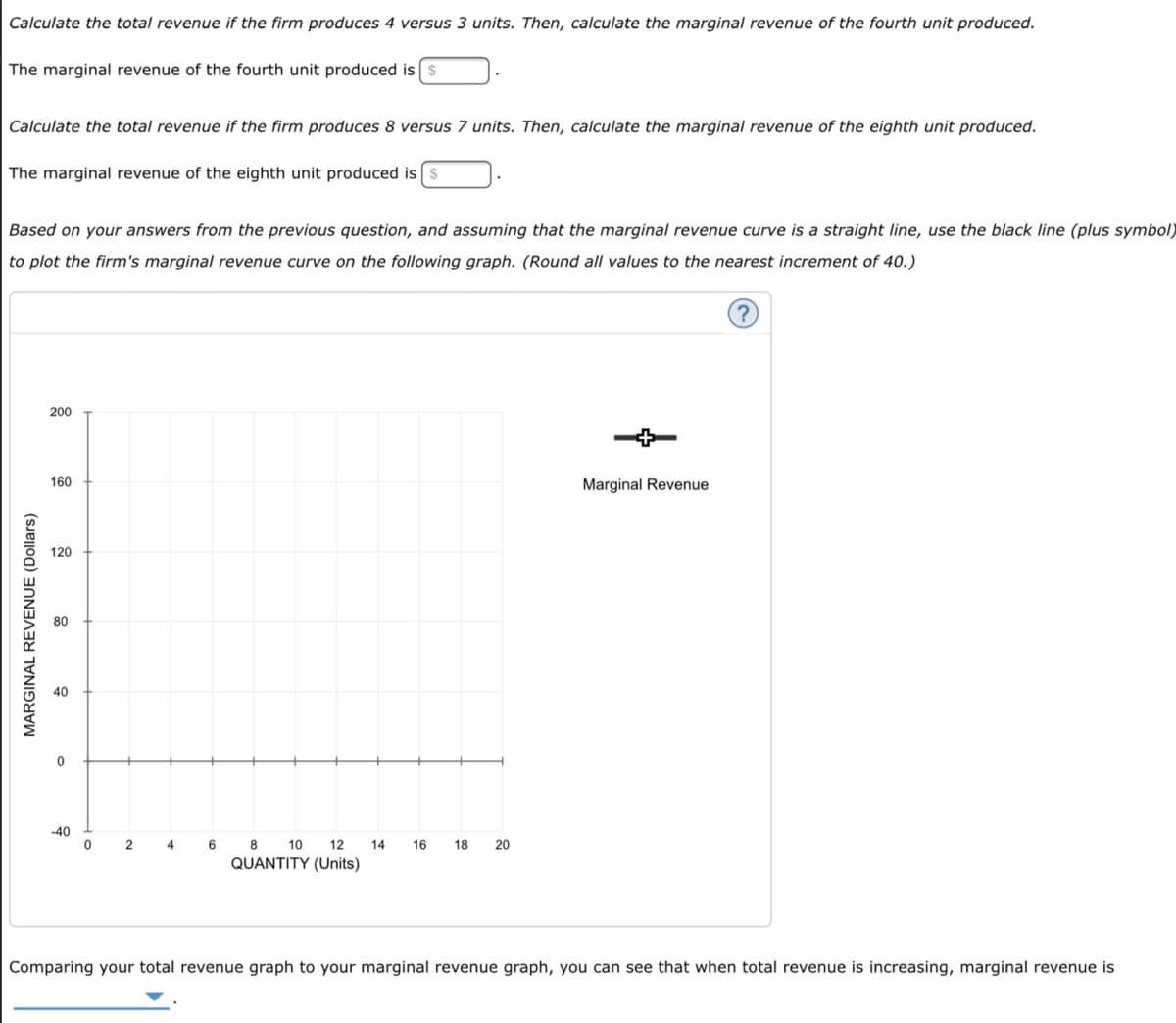The blue curve on the following graph represents the demand curve facing a firm that can set its own prices. Use the graph input tool to help you answer the following questions. You will not be graded on any changes you make to this graph. Note: Once you enter a value in a white field, the graph and any corresponding amounts in each grey field will change accordingly. Graph Input Tool ? Market for Goods 200 180 10 Quantity Demanded (Units) 160 140 Demand Price (Dollars per unit) 100.00 120 100 80 60 Demand 40 20 0 0 2 6 8 10 12 14 16 18 20 QUANTITY (Units) On the graph input tool, change the number found in the Quantity Demanded field to determine the prices that correspond to the production of 8, 10, 12, 16, and 20 units of output. Calculate the total revenue for each of these production levels. Then, on the following graph, use the gree points (triangle symbol) to plot the results. (?) 1000 900 Total Revenue 800 700 600 500 400 300 200 100 0 PRICE (Dollars per unit) TOTAL REVENUE (Dollars) 0 2 4 4 6 8 10 12 14 16 QUANTITY (Number of units) 18 20
The blue curve on the following graph represents the demand curve facing a firm that can set its own prices. Use the graph input tool to help you answer the following questions. You will not be graded on any changes you make to this graph. Note: Once you enter a value in a white field, the graph and any corresponding amounts in each grey field will change accordingly. Graph Input Tool ? Market for Goods 200 180 10 Quantity Demanded (Units) 160 140 Demand Price (Dollars per unit) 100.00 120 100 80 60 Demand 40 20 0 0 2 6 8 10 12 14 16 18 20 QUANTITY (Units) On the graph input tool, change the number found in the Quantity Demanded field to determine the prices that correspond to the production of 8, 10, 12, 16, and 20 units of output. Calculate the total revenue for each of these production levels. Then, on the following graph, use the gree points (triangle symbol) to plot the results. (?) 1000 900 Total Revenue 800 700 600 500 400 300 200 100 0 PRICE (Dollars per unit) TOTAL REVENUE (Dollars) 0 2 4 4 6 8 10 12 14 16 QUANTITY (Number of units) 18 20
Chapter8: Perfect Competition
Section: Chapter Questions
Problem 7.15P
Related questions
Question

Transcribed Image Text:2. Calculating marginal revenue from a linear demand curve
The blue curve on the following graph represents the demand curve facing a firm that can set its own prices.
Use the graph input tool to help you answer the following questions. You will not be graded on any changes you make to this graph.
Note: Once you enter a value in a white field, the graph and any corresponding amounts in each grey field will change accordingly.
Graph Input Tool
(?)
Market for Goods
200
180
10
Quantity
Demanded
(Units)
160
140
Demand Price
(Dollars per unit)
100.00
120
100
80
60
Demand
40
20
-
0
0
2
6 8 10 12 14
16 18 20
QUANTITY (Units)
On the graph input tool, change the number found in the Quantity Demanded field to determine the prices that correspond to the production of 0, 4,
8, 10, 12, 16, and 20 units of output. Calculate the total revenue for each of these production levels. Then, on the following graph, use the green
points (triangle symbol) to plot the results.
(?)
1000
900
Total Revenue
800
700
600
500
400
300
200
100
0
PRICE (Dollars per unit)
TOTAL REVENUE (Dollars)
0
2
4
4
6
8 10 12 14
QUANTITY (Number of units)
16
18 20

Transcribed Image Text:Calculate the total revenue if the firm produces 4 versus 3 units. Then, calculate the marginal revenue of the fourth unit produced.
The marginal revenue of the fourth unit produced is
Calculate the total revenue if the firm produces 8 versus 7 units. Then, calculate the marginal revenue of the eighth unit produced.
The marginal revenue of the eighth unit produced is
Based on your answers from the previous question, and assuming that the marginal revenue curve is a straight line, use the black line (plus symbol)
to plot the firm's marginal revenue curve on the following graph. (Round all values to the nearest increment of 40.)
200
160
120
80
0
2
4
8
10
12
16
18 20
QUANTITY (Units)
Comparing your total revenue graph to your marginal revenue graph, you can see that when total revenue increasing, marginal revenue is
MARGINAL REVENUE (Dollars)
40
0
-40
6
14
+
Marginal Revenue
Expert Solution
This question has been solved!
Explore an expertly crafted, step-by-step solution for a thorough understanding of key concepts.
This is a popular solution!
Trending now
This is a popular solution!
Step by step
Solved in 2 steps with 2 images

Knowledge Booster
Learn more about
Need a deep-dive on the concept behind this application? Look no further. Learn more about this topic, economics and related others by exploring similar questions and additional content below.Recommended textbooks for you


Principles of Economics 2e
Economics
ISBN:
9781947172364
Author:
Steven A. Greenlaw; David Shapiro
Publisher:
OpenStax

Principles of Microeconomics
Economics
ISBN:
9781305156050
Author:
N. Gregory Mankiw
Publisher:
Cengage Learning


Principles of Economics 2e
Economics
ISBN:
9781947172364
Author:
Steven A. Greenlaw; David Shapiro
Publisher:
OpenStax

Principles of Microeconomics
Economics
ISBN:
9781305156050
Author:
N. Gregory Mankiw
Publisher:
Cengage Learning

Principles of Economics, 7th Edition (MindTap Cou…
Economics
ISBN:
9781285165875
Author:
N. Gregory Mankiw
Publisher:
Cengage Learning

Essentials of Economics (MindTap Course List)
Economics
ISBN:
9781337091992
Author:
N. Gregory Mankiw
Publisher:
Cengage Learning

Principles of Microeconomics (MindTap Course List)
Economics
ISBN:
9781305971493
Author:
N. Gregory Mankiw
Publisher:
Cengage Learning